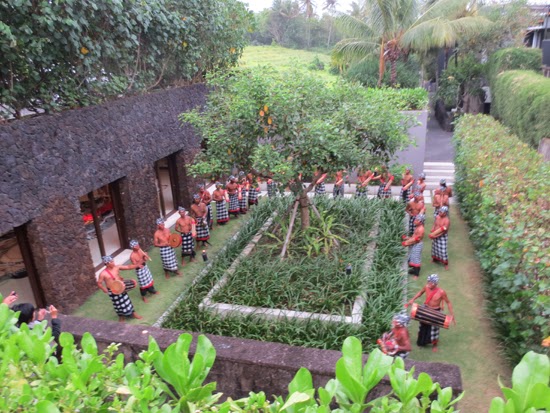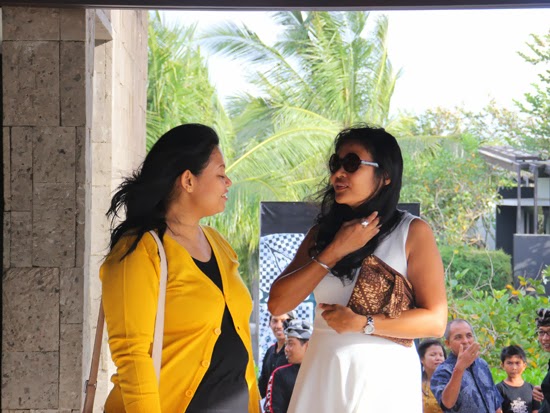Its the exhibition opening day for Ponco Setyohadi again, when I think that I am done and seen all of the culture and traditions of Bali, the amazing Tek-Tekan dance opened the show and made my heart jump with joy. The amazing dynamic, and how the music was played, I just don't want them to stop. Originally played for 4 hours non stop, this one plays for 20 minutes, I love it!
I hope you guys didnt' think its too much of images, there are hundreds of them and I have narrow down the hundreds into these ones, enjoy the picture you guys!
Write up by I Wayan Jengki :
Poleng fabric has a very deep meaning and philosophy. For the Balinese Hindu’s, Poleng fabric is associated with the concept of Rwa Bhineda, Triguna, Tri Murti, Sekala and Niskala.
Therefore, some sacred objects, statues, trees, and stones are wrapped in Poleng fabric. Poleng fabrics are also wrapped on Pecalang (indigenous security personnel) as costume while they performing their duty.
There are 4 types of Poleng motifs;
- Poleng Rwa Bhineda (black-white) symbolizing dualism, such as good-bad, life-death, etc.
- Poleng Sudhamala (black-white-grey), as a form of the balance in dualism, the balance is represented by the color grey.
- Poleng Tridatu (black-white-red), related to Tridatu concept, with the color white symbolizing Satwam (awareness, wisdom), the color red symbolize Rajas (energy of life), the color black symbolize Tamas (negative energy /obstacles). Tridatu also identical to the tri Murti concept which is Brahma (red, the creator), Wisnu (black the keeper), and Siwa (white the fuser). Tridatu is related to birth, life and death.
- Poleng Anyar, which are used daily and not for ceremonial purposes are using modified colors and motifs.
The philosophy and colors of Poleng tooks Ponco Setyohadi’s attention –painter originated from Malang that settled in Bali since 1992. Ponco did a six months research on Poleng in order to explore for his latest work. He did library research, documentation, observation, and in-depth interviews with several Hindu religious leaders.
The result of the research has transformed into works of art and installations that are exhibited in Alila Villas Soori, Kelating beach, Kerambitan, Tabanan – Bali.
Ponco studied art at the IKIP Malang, but has been interested in the Balinese culture for a very long time, he considered Bali as his second home town. Since he lived in Bali, he has worked many jobs, from drainage builder to jewelry designer at John Hardy Inc. He has accomplished many including being appointed as one of Indonesian “Gc (Guess Collection) Smart Luxury Personality” by Sequel AG (Switzerland); as the personality representing painter genre.
In order to explore more about the art of the world, Ponco has traveled to many places in Europe, South East Asia and China. He has deepen his knowledge and insight by visiting museums and places in Rome, Vatican, Paris, Prague, Amsterdam, Barcelona, Vienna, Beijing, Xian, and many other places.
As a painter, Ponco explored and applied several of theme, technique and styles. He masters the expressionism, realism, romantics, naturalism, symbolism and abstract. You can visit his work online www.art-poncos.com and he has exhibited in the events such as “Gc Smart Luxury” in Nusa Dua (2012), “Bali on The Move” in Maha Art Gallery Denpasar (2013), “Kuta Art-Chromatic” in Alas Arum, Seminyak (2013). His solo exhibition was displayed in Villa Watu Sangging, Nyambu- Tabanan (2013).
On this second solo exhibition with “Poleng” as the theme, art enthusiast can witness the transformation of his arts, from realism to symbolic and abstract.
Ponco reveals the fact that when he did the research on the Poleng fabric, at the beginning he was interested in the colors, shape and the implementation in Balinese religious life; then he creates realism paintings related to the Poleng fabric. But as he studied more and in-depth about the Poleng fabric, he found a universal philosophy within it. The afterthought delivers works that are tending to be symbolic and abstract.
Ponco’s works here tend to show explorations on techniques, textures, and symbols. In fact, he wears his palms and fingers instead of brush and palette. It is shown in the work of Five Pecalang (traditional security man), which are Jagabhaya (the village traditional security men), Jagawana (the wood/ forest traditional security men), Pangliman Toya (the rice-fields traditional security men), Bendega (the fisherman’s traditional security men), dan Sawung Tanggur (the cock-fight traditional security men).
Pecalang means vigilant, from the word “calang” means alert, watchful, wary, cautious, wide-awake, etc. Ponco’s works here implies that human being must always be vigilant wherever they are.
On the other paintings, Ponco has processed Balinese magical symbols and mystical sketches associated with Poleng fabric. It is shown in the paintings titled Deling, Manca Rupa, Mega Mendung, Sasuruh Ijo, and Tumpal Poleng. Ponco adjust the texture then associate the energy & philosophy of the symbols.
On to the mixed media work, Ponco use the Poleng fabric on his paintings with particular composition. You can see it in the paintings titled Nyelem Putihang Gumi, Pager Poleng, Pondasi Poleng.
Meanwhile, in the installation art-work, it is made out of selection of Poleng fabric, Barong hair and Kepeng coin, very contemplative and exudes magic.
Based on Ponco’s understanding and interpretation of Poleng philosophy, his works denote a lot about the value of humanity, about self-control and self- introspective. Ponco said, if mankind is able to practice Poleng philosophy in everyday life; life will be more peaceful and harmonious.
the artist: Ponco Setyohadi
thank you all for viewing the post....
xxx
dress Simply Chic | heels Nine West | bag Batik Keris | jewelry John Hardy | watch Gc Collection
























